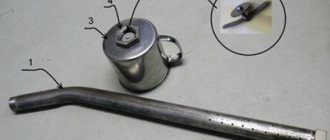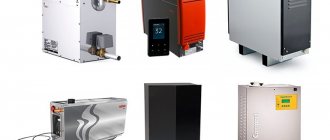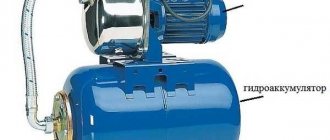Are there any fundamental differences between steam generators for baths, saunas and hammam?
Many people are interested in the question, what is the difference between steam generators for a bath, sauna or hammam? Since all three types of structures are intended not only for washing, but also for healing the body, their action is based on the formation of steam. The difference between a bathhouse, a sauna and a hammam is the amount of steam produced, its temperature and humidity level.
Temperature conditions of different types of steam rooms:
- A Finnish sauna must have dry heat - the temperature ranges from 80 to 140°C, the humidity level is from 1 to 15%.
- There must be wet steam in a Turkish hammam - the temperature is maintained at 45°C - the humidity level is 100%.
- In a Russian bath, steam should have an optimal humidity level from 50 to 80%, and the temperature should be maintained from 60 to 80°C.
A “store” steam generator, which has many operating modes for generating steam, is suitable for all types of steam rooms. Using the remote control, you can independently set the temperature of the steam and its volume. Typically, such devices allow you to select temperatures up to 95°C. Also, steam generators for industrial use are equipped with special built-in programs that can independently create a certain temperature and volume of steam output, simulating a real Russian bathhouse, Finnish sauna or Turkish hammam.
The steam that a steam gun creates is softer and more gentle than that from pouring water onto hot stones. Thus, we can say that there are no significant differences in such devices, so they are suitable for all types of steam rooms.
Bath stove with steam gun
It should be noted that the raw steam, which is necessary for the hammam, is not too heavy for the human body, does not give the feeling of a suffocating atmosphere, since the room is heated only to a maximum high temperature of 45°C. And it is with the help of a steam generator that this result can be achieved.
I would like to note that a modern Russian bathhouse is not too different from a Finnish sauna in its design. Therefore, the amount of steam and its temperature in such steam rooms can be coordinated by the visitors themselves. Using a steam generator, you can create conditions in any steam room that are intended for a bathhouse, sauna or hammam.
Steam Features
Depending on the type of bath, the steam in the steam room differs.
Bath masters distinguish many types of steam. Depending on the temperature conditions in the steam room, several steam-air mixtures are formed from floor to ceiling.
A steam installation in a bathhouse can generate the following types of steam.
- Burning – supersaturated steam. Creates a hot dew on the skin and then turns into a rich dew. Such steam burns your lips and mouth upon entry and is “visible” as clouds of fog.
- Light – overheated, but not rich. It cools around the person, and only when it reaches the condensation point does it form dew on the skin. It does not burn - it tingles the ears, transfers heat deep into the nasopharynx and even the bronchi and is considered the most useful in the treatment of diseases of the respiratory system. No steam is visible.
- Damp – Contains droplets of water or mist. It usually results from the explosive evaporation of water on a coarse-textured surface. In this case, the water does not evaporate completely and forms separate drops. It is not very pleasant, as it creates a contrast between pleasant fine steam and large, highly heated drops.
To prevent the production of raw steam, sprinklers are often installed on the heater. They allow evaporated water to pass through, but trap droplets.
Tips for use
- Steam guns of simple design, which we examined in the first two options, do not require complex maintenance, since if there is no water in them, then steam simply will not be released.
- The steam generator has a heating element in its design, which, with constant contact with water, will “collect” scale on its surface. In order to increase the life of such a device, it is necessary to regularly inspect the heating elements and remove accumulated formations.
- It is recommended to install the steam generator not in the steam room, but in the next room, so that the device is protected from contact with a humid environment.
Making a steam generator with your own hands
To make a steam generator, a home craftsman will need a container of water, a heating source, a steam line, control and monitoring devices.
A pressure cooker, a cut-off gas cylinder, a decommissioned used boiler, etc. are used as a container. The container must be hermetically sealed and withstand increased pressure.
A tube with drilled holes must be inserted into the cedar barrel.
The heating source can be either an open flame, as in a heating boiler, or electric heaters. The power of the device is selected so that the water boils with a large release of steam. Water boiling is controlled using a built-in thermometer and pressure gauge, and adjustment is done using valves: shut-off, outlet and safety valves. If possible, fill sensors are installed to indicate the lower and upper levels at which steam generation is allowed.
The safety valve, through which excess pressure is released, is an important element of the safety system. Its selection and adjustment should be approached with special care. If a safety valve is not installed, there should be no shut-off valves on the steam line to limit the steam output. The tank is filled with water through a connection to the water supply or to a separate expansion tank located above the boiler.
High-pressure pipes made of stainless steel, cast iron or metal-plastic are used as a steam pipeline. The material must be chemically neutral and not emit harmful substances when heated. It should be remembered that a boiler under pressure is a source of increased danger. It is no coincidence that such an organization exists - boiler inspection. The design and operation of a homemade steam generator requires experience, knowledge and skills.
The place where the steam generator will be located must be dry and well ventilated
The main advantage of the steam generator is that its design can be gradually complicated by adding controls. Which, in turn, allows you to vary steam production over a wide range of volume, temperature and dispersion, selecting the most comfortable conditions for the individual user.
Video: homemade steam generator
Step by Step Actions
- The funnel is prepared (take a ready-made one or make it from a stainless steel sheet)
- A check valve is mounted and a corrugated pipe is connected using a fitting. It can also be regular tap water.
- Using connecting elements, a device is manufactured in a shape that is suitable for placement in a stove-heater.
- Sections of corrugated pipe will serve as steam diffusers. A series of holes up to 2 mm in diameter are drilled onto them. If water evaporates at an accelerated rate during testing, some holes can be closed with self-tapping screws.
- The finished steam gun is placed in the oven and laid on top with stones.
During the first tests, the homemade device is filled with liquid in a limited amount, and the oven does not heat up completely. If the tests are successful, then you can test it in operating mode.
A homemade generator is easy to make, and a craftsman can make it within one day. It is impossible to completely replace the factory device, but as a result, a more comfortable atmosphere and better conditions for healing will be created in the bathhouse.
Preparation of equipment and materials
What you will need for manufacturing and installation:
- ball valves that can withstand elevated temperatures;
- heating elements (heating elements);
- gaskets for heating elements (they must be heat-resistant);
- safety valve;
- a hose is used for the steam line;
- bends with corresponding connecting diameters;
- a container that can withstand high pressure (for example, an old gas cylinder);
- pressure gauge
Important: The volume of the tank is selected based on the size of the steam room. General rule: for a 10-liter container, the power of the heating elements should be 3 kW.
The gas cylinder is prepared before use:
- The integrity of the walls is checked for the absence of defects.
- The top valve is carefully removed.
- Water is poured into the cylinder to completely displace gas residues.
- The upper part of the cylinder is cut off at the welding seam.
- The inner surface of the container is thoroughly washed using detergents.
Features of assembling a solid fuel steam generator for a home using wood or coal
Assembly of a solid fuel steam generator is much simpler compared to its electric counterpart, and less expensive. The design will require pipes of various diameters. First you need to make a loading tank, for which you can use a pipe with a diameter of 300 mm. It burns coal or wood. It is also necessary to weld a water container that is installed above the firebox. A register pipe and an adapter should be welded to it, through which the steam will be discharged outside. For more information on how to make a steam generator with your own hands, watch the video.
Video “Features of assembling a solid fuel steam generator with your own hands”:
Types of device
Thanks to this device, you can make your life much easier. There are 5 types of devices, the principles of operation of which differ significantly from each other:
- Electric ones that operate from the network. If this is a non-industrial model, then you will need a 220 V outlet, and if it is an industrial model - 380 V.
- Induction steam generators. During operation, the electromagnetic field is transformed.
- Stoves. They use solid fuel such as coal or wood for heating.
- Ultrasonic, the principle of which is to evaporate steam using sound vibrations.
- Electrode steam furnace. The heating element is the electrodes.
At home, it is best to make an electric model yourself. To make it you will not need many parts and time. Moreover, if you search well in the garage or barn, you can easily find all the suitable elements.
Results
So, the efficiency of induction boilers is approximately 99%, they operate silently, using any liquid heat carrier, they do not require maintenance, and it is also safe and practical. Although such a boiler is quite expensive, such costs are recouped. And if you create it yourself, it will be even more profitable.
https://youtube.com/watch?v=F6yIXht5gks
Of course, the choice is yours, but it’s better to contact specialists who will tell you whether such heating is suitable for you. But, in general, induction boilers are an excellent alternative to traditional heating systems. Date: September 25, 2021
How is the wiring of steam heating from the furnace arranged?
In this case, most experts recommend a single-circuit wiring option.
This steam heating scheme from a furnace is arranged as follows:
- A vertical branch of the pipeline rises from the pressure pipe of the heat exchanger, turning into a horizontal branch near the ceiling.
- At the junction of the vertical and horizontal branches of the pressure pipeline, a tee is inserted, which is used to connect the open expansion tank. This storage device is located behind the ceiling - in the attic.
- The horizontal branch of the pressure pipe stretches to the first battery, at a slope of 2 centimeters per 1 meter of pipeline. Moreover, above the radiator, the horizontal again turns into a vertical, which ends at the upper fitting of the battery.
- From the upper fitting of the first battery to the corresponding “connector” of the next radiator, a connecting pipe is routed, the diameter of which coincides with the dimensions of the pressure branch of the wiring.
- The same pipe “connects” the lower “connectors” of the first and second radiators. In this case, a plug is screwed into the free pipe (under the pressure pipe inlet).
- The second battery is connected to the third according to the same principle, extending a double line from radiator to radiator to the extreme position.
- The last (in front of the stove) radiator “receives” the upper and lower pipes from the penultimate one at one edge. On the other hand, a tube is screwed into the lower pipe of the outermost battery, connecting it to the return pipe of the heat exchanger in the furnace. A Mayevsky tap is screwed into the free upper pipe of the outermost battery - with its help, air is bleed from the wiring.
- Pressure equipment is installed between the furnace and the outermost battery - in the return line, using a standard bypass for pumps.
The wiring arranged in this way supports both forced and natural circulation of the coolant. Simply put: your furnace will heat your home using radiators even when there is no electricity at the outlet. That is, by acting in this way, you will achieve complete energy autonomy of your home heating system.
https://youtube.com/watch?v=fm_dud7HRyQ
We also recommend watching:
- Glass doors for stoves and fireplaces
- Fireproof heat resistant glass for fireplace
- What is the optimal pressure in the heating system of a multi-storey building?
- Thermal insulation of a stainless steel chimney pipe
Selecting a heating element
Note! An electric heater (TEH) is essentially a large boiler used to heat large volumes of water, which you can purchase at any hardware store. But before purchasing it, you should decide on the size and power of the electric heater, which can vary widely.
If you decide to save on a heater, you can disassemble an old-style household electric kettle or electric samovar and use the heating element built into it.
Heating element with a used electric samovar
Note! Using a heating element from a modern electric kettle will require the invention of more complex fasteners. Also, the contacts of such heating elements are not intended for fixing wires on them
Heating element from an electric kettle
Choosing the right container
Suitable container for making the device
An old pressure cooker, in which the steam generation effect is provided for by its very design, can be used as a body or working container for a future steam generator. (If you don’t have the old appliance, you can purchase a new pressure cooker at a hardware store).
This steam device fully meets all the requirements necessary for the implementation of our project:
- it is equipped with a hermetically sealed lid;
- the body of the pressure cooker is strong enough to withstand the pressure required for operation;
- the presence of a special valve makes it possible to “bleed off” excess steam.
After choosing a suitable working container, you will need to decide on the method of heating water in the device used to generate steam.
Note! An electric heater (TEH) is essentially a large boiler used to heat large volumes of water, which you can purchase at any hardware store. But before purchasing it, you should decide on the size and power of the electric heater, which can vary widely.
If you decide to save on a heater, you can disassemble an old-style household electric kettle or electric samovar and use the heating element built into it.
Heating element with a used electric samovar
Heating element from an electric kettle
Before assembling the steam generator, it is necessary to accurately calculate the number of devices that ensure the conversion of a given amount of water into steam (to heat large volumes, two or even three heaters may be required).
Water supply methods
Water is supplied to the steam generator tank using two methods:
- self-filling of water by the user;
- automatic supply from the water supply.
If you make a steam generator for a bath yourself, then automatic water supply is more difficult to implement. Another disadvantage of this scheme is that the content of impurities in tap water or its increased hardness quickly provokes the formation of scale, which will require frequent cleaning. When filling the reservoir manually, you can use distilled water.
You can also familiarize yourself with the reasons why water may leak from the steam generator.
Technical capabilities
Manufacturers strive to make their steam generators not only productive and reliable, but also multifunctional. Modern installations are capable of operating in a variety of modes, which are configured on an intuitive control panel.
One of the useful functions of factory steam generators is the ability to produce steam at a given temperature in the range of 35-95 degrees. In this case, you can set the intensity of steam generation by setting time intervals.
Since a steam generator is more often used for steam rooms, they are often capable of producing steam corresponding to a Finnish or, for example, Russian bath. A few drops of a special aromatic preparation will give it a more pleasant smell.











